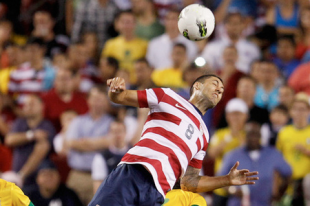Photo: Courtesy of The Shin Guardian
In a span of eighteen days ending last Tuesday, the USMNT played Scotland, Brazil, Canada, Antigua & Barbuda, and Guatemala, finishing with a record of two wins, two ties, and 1 loss. In the games that mattered for World Cup Qualifying, they garnered four points, and currently top their qualifying group. Taken out of context, and considering that the loss came against five-time World Champion Brazil, these are good results. But looking back at the games as a sequence, it’s hard not to be disappointed.
Against Scotland, the U.S. played as well as I have seen them play, controlling the game with a passing tempo and workrate that Scotland simply could not match, allied with excellent finishing. Then came Brazil, and while it took a half to get going, the team managed to play at a similarly high level, regardless of the scoreline. In the ensuing three games, however, the U.S. never found that rhythm and energy, and struggled to play well against teams they should beat.
It’s unusual, outside of a tournament, to see the team play so many games in so short a time, and it gives us a chance to assess the progress that the U.S. has made under Juergen Klinsmann. Let’s take a look at the positives first, then some negatives, and finally, we’ll peek ahead.
Positives
- We have some very good players. For years, one of the major knocks against the U.S. when compared to the big European and South American teams was that there was a talent gap. That gap is closing. True, we have no Neymar, no Messi, no Cristiano Ronaldo, but players like Clint Dempsey, Landon Donovan, and Michael Bradley are top-class talents, and younger players coming through like Fabian Johnson and Jozy Altidore (22-years-old–he only seems like he’s been around forever) give hope for the future, too.
- We can play good soccer. Klinsmann was brought in for many reasons, but a big one was to transform the U.S.’s style of play from a system of functional athleticism to something with panache. To be frank, I think he’s ahead of schedule. Against teams unable to effectively park the bus, or that actually want to play a game of football, the U.S. can really move the ball and make things happen. And the athleticism and workrate that has been a hallmark of U.S. teams through the years remains.
Negatives
- We play in CONCACAF. When the U.S. beat Scotland, I said that the midfield trio of Bradley, Maurice Edu, and Jermaine Jones was comfortably our first-choice. I still believe that, but before kick-off against Scotland, I was also wary that there was not enough offensive creativity there, and Canada, A&B, and Guatemala exposed that. Michael Bradley can only do so much. He’s the engine room and the most creative player, but also the most defensively-aware, so against teams that sit deep and play on the counter, he needs help. If that help comes from the wings, then great, but if Donovan and Dempsey aren’t on it, the team struggles to open up packed defenses. Strangely, it seems that the U.S. may be better suited to playing European and South American teams than our regional neighbors.
- Selection problems? Another feature of the Scotland win was the marked absence of two of the U.S.’s most in form offensive players, Dempsey and Altidore. Herculez Gomez, also in form, was kept on the bench. Yet, with Terrence Boyd up top as the focal point, and Jose Torres pushed up on the left side, the midfield ball-players had a field day, playing keep away and one-touch, running Scotland ragged. While Gomez has shined since coming into the side, neither Dempsey nor Altidore has given more than glimpses of what they’re capable of, and the fluidity of the Scotland and Brazil games has disappeared. That’s not to say they should be benched, but simply to point out that different players require different tactics, and perhaps Klinsmann needs more time to figure out how best to incorporate their talents into the game plan.
Looking Ahead
The U.S. next plays Jamaica at home (Columbus Crew Stadium), on September 11th, then sees Guatemala again, this time in Kansas City (LIVESTRONG Sporting Park), on October 16th. The non-U.S.-based players now get to go home and take their summer vacation, while those in MLS return to their club teams. In both cases, I think this is a good thing. The European-based players, including Dempsey and Altidore, were coming off of long seasons, and could use the break. By September, they will be rejuvenated and fit. The MLS-based players will be heading into that league’s playoff stretch run, playing meaningful games each week, and should be razor-sharp.
Barring injuries to key players, the main questions will be what changes, if any, Klinsmann will make. 4-3-3 seems the preferred formation now, but will there be any selection surprises or lineup changes? Will playing at home make a difference to the freedom with which the U.S. plays?
No matter what, the U.S. should head into those autumn games with confidence. While the past few games may have been somewhat disappointing, the U.S. will be favorites against Jamaica and Guatemala, and should be. Let’s hope that the Juergen Klinsmann project continues to accelerate!


Cant wait to see what Williams prospects for NT RB become now that Chandler has backed out.
Sheanon Williams is not a NT-caliber RB. Eric Lichaj starts for Aston Villa and remains the clear option there (unless he goes to LB and they push Johnson upfield). Alfredo Morales also ahead in the pecking order, with Cherundolo the current starter. Love Sheanon but let him get back to playing RB before we thinking national team.
Yes, not right now at all. I said prospects. His age is also a big plus, 22 is relatively young considering someone like Cameron can get into the NT at 26 and be considered a “young” CB option for us. And he is getting European interest now too.
Williams future is very bright.
Since you mentioned Williams, I’ll ask the question I’ve been pondering for a while. Would he be a good fit at LB, instead of RB? His strength going forward seems to be more on diagonal runs into the box, rather than running to the corner and crossing. Coming in from the left would put him on his stronger foot. Just a thought, and I’ll leave it to the experts to explain why it’s a bad one. 🙂
Williams has played at LB for the Union on a couple occasions, I believe. He is okay there, but he is so right-foot-dominant that is makes maneuvering along the sideline and beating defenders awkward. Were he to improve his left foot some, I’d probably be open to the idea.
You would think they got better as they played more games; instead they got worse which is very worrying. Am not convinced Klinsmann is the right coach; rather see him go to Tottenham.
I think it’s hard to gauge it that way. The type and quality of the competition changed a great deal over the five games. CONCACAF games play very differently than against Euro or South American opposition. I like Klinsmann, and will reserve judgement until the qualifying process is much further along. If he gets us to the WC finals, then I think he also deserves the chance to coach the team through the tournament.
You mean to the WC. The finals are at the end of the tournament. It is rather easy to get to the WC. The problem is once there getting out of your group and getting to the quarter finals. This is why he was hired. I have my doubts that he and his current support staff will be able to put a tactical strong team together that makes much noise at the next WC. I would change my mind if he would hire much better support staff.
We are talking about the same thing. The World Cup Finals refers to the whole World Cup tournament for which we are now in qualifying.
I agree about the doubts about a strong tactical team – but because Klinnsman is not going to be able to do anything about the players available to him which were brought up in the old and outdated youth system.
The best part of Klinnsman reign is his insistence on changing this system up and seeing that it creates much better players for the future. for this, I think he was the right guy.